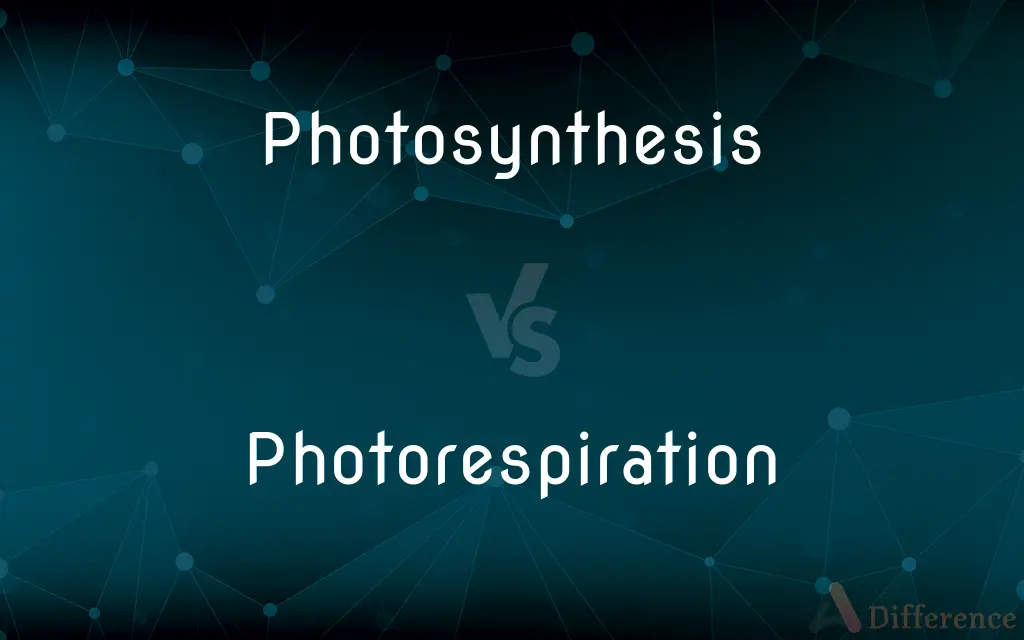Photosynthesis vs. Photorespiration — What's the Difference?
By Tayyaba Rehman & Fiza Rafique — Updated on March 21, 2024
Photosynthesis is the process by which plants convert light energy into chemical energy, producing oxygen, whereas photorespiration consumes oxygen and releases carbon dioxide, often considered wasteful.

Difference Between Photosynthesis and Photorespiration
Table of Contents
ADVERTISEMENT
Key Differences
Photosynthesis is a critical biological process in which plants, algae, and some bacteria convert light energy, usually from the sun, into chemical energy stored in glucose, a type of sugar. This process is essential for the growth and energy needs of these organisms and for producing the oxygen necessary for most life forms on Earth. On the other hand, photorespiration is a process that occurs in many plants where oxygen is taken up and carbon dioxide is released, essentially counteracting photosynthesis by consuming energy and releasing carbon dioxide, which is often considered an inefficient or wasteful process.
While photosynthesis occurs in the chloroplasts of plant cells where light is abundant, photorespiration primarily takes place in the mitochondria and peroxisomes, indicating a complex interaction between different cellular components. The conditions favoring photosynthesis and photorespiration also differ; photosynthesis is most efficient under high light intensity and carbon dioxide levels, whereas photorespiration is promoted under high oxygen levels, often as a result of high light conditions that enhance the splitting of water in the light-dependent reactions of photosynthesis.
The significance of these processes to the plant and the ecosystem varies greatly. Photosynthesis is fundamental to the Earth's carbon cycle, contributing to the atmospheric oxygen we breathe and serving as the base of the planet's food chain. Photorespiration, while less understood, is believed to play roles in protecting plants from photooxidative damage and possibly in recycling metabolites, despite its apparent inefficiency in terms of carbon fixation compared to photosynthesis.
Understanding the distinction between photosynthesis and photorespiration is crucial for advancements in agricultural science and biotechnology. Enhancing photosynthetic efficiency and reducing photorespiratory losses are key objectives in crop improvement research, aimed at increasing food production to meet the needs of a growing global population.
Both photosynthesis and photorespiration are influenced by environmental factors such as light intensity, temperature, and the availability of water and nutrients. However, their responses to these factors can be quite different, with photosynthesis generally being more adaptable to varying environmental conditions compared to the more constant rate of photorespiration, which can lead to greater inefficiencies under stress conditions.
ADVERTISEMENT
Comparison Chart
Primary Function
Converts light energy to chemical energy, producing oxygen.
Consumes oxygen and releases carbon dioxide, using energy.
Location in Cell
Chloroplasts
Mitochondria and peroxisomes
Environmental Conditions
Favored by high light and CO2 levels.
Promoted under high oxygen levels.
Significance
Essential for plant growth, oxygen production, and the global carbon cycle.
Considered inefficient, but may protect against photooxidative damage.
Response to Environmental Factors
Adaptable to varying conditions, efficiency influenced by light, CO2, and water.
Less adaptable, can lead to inefficiencies under stress.
Compare with Definitions
Photosynthesis
Converts solar energy into glucose, storing chemical energy.
Through photosynthesis, plants produce the glucose they need for growth.
Photorespiration
May help mitigate photooxidative damage.
Photorespiration might protect plants in high light conditions by consuming excess energy.
Photosynthesis
Produces oxygen as a byproduct, essential for life.
The oxygen in our atmosphere is largely the result of photosynthesis.
Photorespiration
Consumes oxygen, releasing CO2, opposite to photosynthesis.
During photorespiration, plants release some of the CO2 fixed during photosynthesis.
Photosynthesis
Takes place in the chlorophyll-containing chloroplasts.
Chloroplasts in plant cells capture light for photosynthesis.
Photorespiration
Uses energy without producing ATP or glucose.
Photorespiration is seen as wasteful as it consumes energy and sugars.
Photosynthesis
Requires light, with efficiency varying by intensity.
Photosynthesis rates increase with sunlight, peaking at midday.
Photorespiration
Occurs across mitochondria, chloroplasts, and peroxisomes.
Photorespiration involves a complex pathway spanning several cell organelles.
Photosynthesis
Varies with environmental factors like CO2 and water.
Photosynthesis can slow down under drought conditions.
Photorespiration
Elevated oxygen levels increase photorespiration.
On hot, dry days, photorespiration rates can surge due to stomatal closure.
Photosynthesis
Photosynthesis is a process used by plants and other organisms to convert light energy into chemical energy that, through cellular respiration, can later be released to fuel the organism's metabolic activities. This chemical energy is stored in carbohydrate molecules, such as sugars and starches, which are synthesized from carbon dioxide and water – hence the name photosynthesis, from the Greek phōs (φῶς), "light", and sunthesis (σύνθεσις), "putting together".
Photorespiration
Photorespiration (also known as the oxidative photosynthetic carbon cycle, or C2 photosynthesis) refers to a process in plant metabolism where the enzyme RuBisCO oxygenates RuBP, wasting some of the energy produced by photosynthesis. The desired reaction is the addition of carbon dioxide to RuBP (carboxylation), a key step in the Calvin–Benson cycle, but approximately 25% of reactions by RuBisCO instead add oxygen to RuBP (oxygenation), creating a product that cannot be used within the Calvin–Benson cycle.
Photosynthesis
The process in green plants and certain other organisms by which carbohydrates are synthesized from carbon dioxide and a source of hydrogen (usually water), using light as an energy source. Most forms of photosynthesis release oxygen as a byproduct.
Photorespiration
Oxidation of carbohydrates in plants with the release of carbon dioxide during photosynthesis.
Photosynthesis
(biology) Any process by which plants and other photoautotrophs convert light energy into chemical energy,
Photorespiration
(biology) The light-dependent release of carbon dioxide and uptake of oxygen in photosynthetic organisms as an unavoidable side reaction of photosynthesis.
Photosynthesis
Principally, oxygenic photosynthesis, any process by which plants and algae convert water and carbon dioxide into carbohydrates and waste oxygen using solar energy.
Photosynthesis
Also, non-oxygenic photosynthesis, used by purple and green bacteria, heliobacteria, and acidobacteria.
Photosynthesis
The process of constructive metabolism by which carbohydrates are formed from water vapor and the carbon dioxide of the air in the chlorophyll-containing tissues of plants exposed to the action of light. It was formerly called assimilation, but this is now commonly used as in animal physiology. The details of the process are not yet clearly known. Baeyer's theory is that the carbon dioxide is reduced to carbon monoxide, which, uniting with the hydrogen of the water in the cell, produces formaldehyde, the latter forming various sugars through polymerization. Vines suggests that the carbohydrates are secretion products of the chloroplasts, derived from decomposition of previously formed proteids. The food substances are usually quickly translocated, those that accumulate being changed to starch, which appears in the cells almost simultaneously with the sugars. The chloroplasts perform photosynthesis only in light and within a certain range of temperature, varying according to climate. This is the only way in which a plant is able to organize carbohydrates. All plants without a chlorophyll apparatus, as the fungi, must be parasitic or saprophytic.
Photosynthesis
Synthesis of compounds with the aid of radiant energy (especially in plants)
Common Curiosities
What is photosynthesis?
Photosynthesis is the process by which green plants and some other organisms use sunlight to synthesize nutrients from carbon dioxide and water, producing oxygen as a byproduct.
Can the rate of photorespiration be reduced?
Yes, the rate of photorespiration can be reduced by increasing carbon dioxide concentration around the leaves or by genetically engineering plants to bypass the photorespiratory pathway.
What is photorespiration?
Photorespiration is a process in plants where oxygen is consumed and carbon dioxide is released, using up energy and sugars, often considered a wasteful counterprocess to photosynthesis.
Why is photorespiration considered inefficient?
Photorespiration is considered inefficient because it consumes oxygen and organic compounds, releasing carbon dioxide without producing ATP or glucose, thus reducing the efficiency of photosynthesis.
How do environmental conditions affect photosynthesis and photorespiration?
Photosynthesis is positively influenced by factors like light intensity and carbon dioxide concentration, while photorespiration increases under high oxygen conditions, often due to high light intensities that enhance the splitting of water in photosynthesis.
Is there any benefit to photorespiration?
While often seen as wasteful, photorespiration may play roles in protecting plants from photooxidative damage and recycling metabolites, although these benefits do not outweigh its cost in terms of reduced photosynthetic efficiency.
How do photosynthesis and photorespiration differ in their impact on plant energy?
Photosynthesis produces energy and sugars necessary for plant growth, whereas photorespiration consumes energy and sugars, reducing the plant's net photosynthetic productivity.
Why does photorespiration increase in hot, dry conditions?
In hot, dry conditions, plants close their stomata to conserve water, which reduces carbon dioxide intake and increases oxygen concentration inside leaves, thereby promoting photorespiration.
What advancements are being made to improve photosynthesis?
Research is focusing on increasing photosynthetic efficiency through genetic engineering, such as altering the RuBisCO enzyme to reduce photorespiration or introducing more efficient photosynthetic pathways from other organisms.
What role does photosynthesis play in the environment?
Photosynthesis is crucial for the Earth's carbon cycle, converting carbon dioxide into oxygen, which is essential for the survival of most life forms, and providing the foundation for the planet's food chain.
Share Your Discovery

Previous Comparison
Hopping vs. Jump
Next Comparison
Unredeemably vs. RedeemAuthor Spotlight
Written by
Tayyaba RehmanTayyaba Rehman is a distinguished writer, currently serving as a primary contributor to askdifference.com. As a researcher in semantics and etymology, Tayyaba's passion for the complexity of languages and their distinctions has found a perfect home on the platform. Tayyaba delves into the intricacies of language, distinguishing between commonly confused words and phrases, thereby providing clarity for readers worldwide.
Co-written by
Fiza RafiqueFiza Rafique is a skilled content writer at AskDifference.com, where she meticulously refines and enhances written pieces. Drawing from her vast editorial expertise, Fiza ensures clarity, accuracy, and precision in every article. Passionate about language, she continually seeks to elevate the quality of content for readers worldwide.














































